Growing Trees on Your Patio? Here’s What Nobody Tells You.
I’ve been working with plants for a couple of decades now, from huge commercial operations to designing tiny backyard gardens. And honestly, the one thing people ask for more than anything else is the magic of a tree without needing a big yard. You see a stunning, mature tree in a fancy pot at a hotel or in a magazine and think, “I want that!”
In this article
And you absolutely can have it. But let’s be real—it’s a whole different ballgame than planting in the ground. It demands a bit more from you.
Think about it: a tree in the earth has a massive support system. Its roots can stretch out for water and food, and the sheer volume of soil keeps it insulated from crazy temperature swings. A tree in a pot? It depends on you for literally everything. So, it’s probably better to think of it less like a plant and more like a long-term pet. One that, with the right care, can live happily for 10-15 years or more on your patio. It needs the right home, a consistent diet, and regular check-ups. This guide is built on everything I’ve learned, including my own screw-ups. I’ve figured out which trees are tough enough, what soil recipes actually work, and how to dodge the common mistakes that leave people with a sad, expensive twig in a nice container.

Why a Pot is a Totally Different World
Before you even dream about which tree to buy, you’ve got to wrap your head around the tiny, artificial world you’re creating inside that pot. Getting this right is, without a doubt, the most important step. So many failures I’ve seen come from folks treating a potted tree like it’s just in a small patch of garden soil. It’s not.
Roots, Water, and a Common Myth
In the ground, water drains away deep into the earth. In a pot, it can only go so far. Now, you’ve probably heard the old advice to put a layer of gravel or broken pottery at the bottom of the pot for drainage. Heads up: this is a total myth.
It actually makes drainage worse. Water doesn’t like to move from a fine material (like your soil) into a coarse one (like gravel). So, it hits that gravel layer and just stops, creating a swampy, soggy zone right at the bottom of the pot. This is called a “perched water table,” and it suffocates the roots. The absolute best drainage comes from using a good, consistent soil mix from top to bottom and having a large, clear drainage hole.
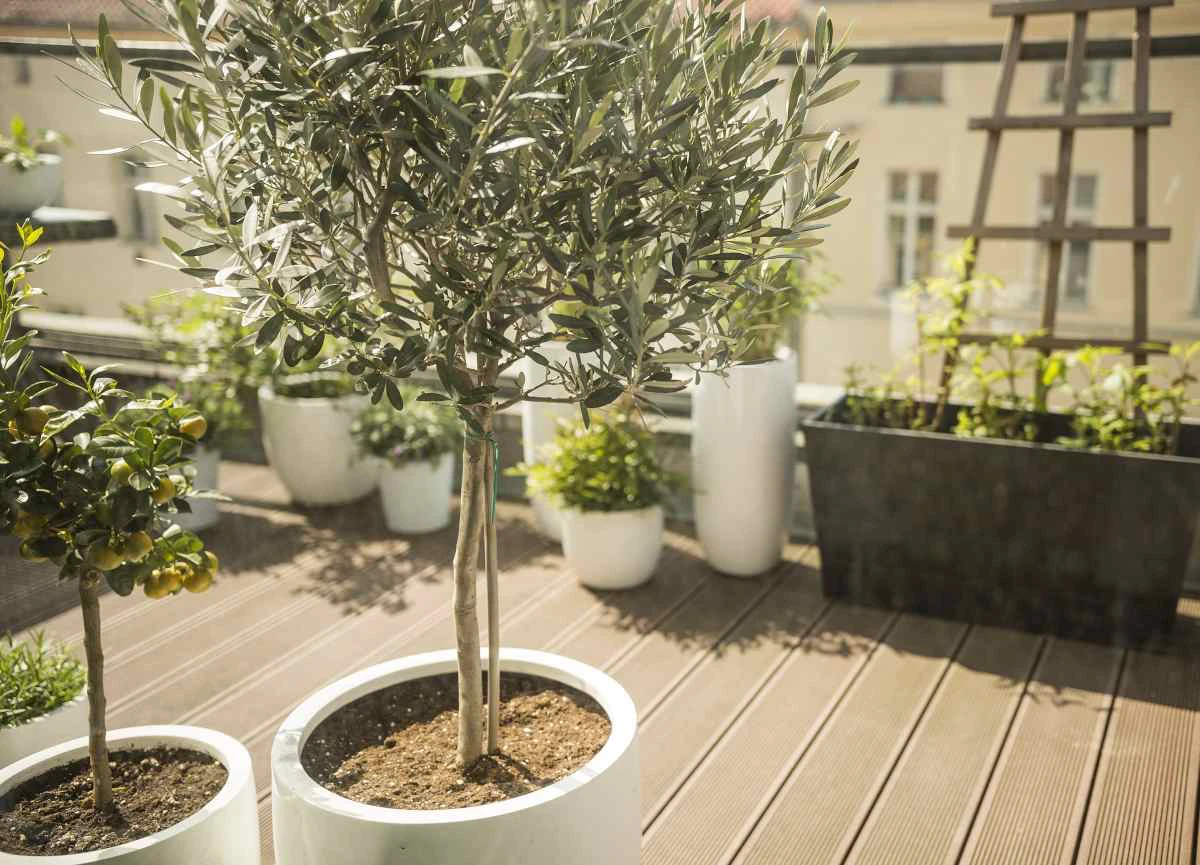
Temperature Swings are a Big Deal
Soil in the ground stays at a remarkably stable temperature. On a blistering summer day, the roots just a few inches down are way cooler than the air. But a pot? It’s completely exposed. A simple black plastic pot sitting in the afternoon sun can get hot enough to literally cook the delicate feeder roots on that side. The same goes for winter—the pot offers almost zero insulation, exposing roots to freezing temperatures they’d never experience in the ground.
Here’s a pro tip: Always choose a tree rated for at least one, and preferably two, USDA hardiness zones colder than where you live. For example, if you’re in Zone 7, a tree rated for Zone 5 has a much better shot at surviving a cold winter in a container.
The Food Situation
Garden soil is a living ecosystem buzzing with microbes that break down organic stuff and release nutrients. Potting soil is mostly sterile and has a very limited pantry. To make matters worse, every single time you water, you’re flushing a little bit of those precious nutrients right out the bottom. A potted tree is a hungry tree, and it’s 100% dependent on you for its food.
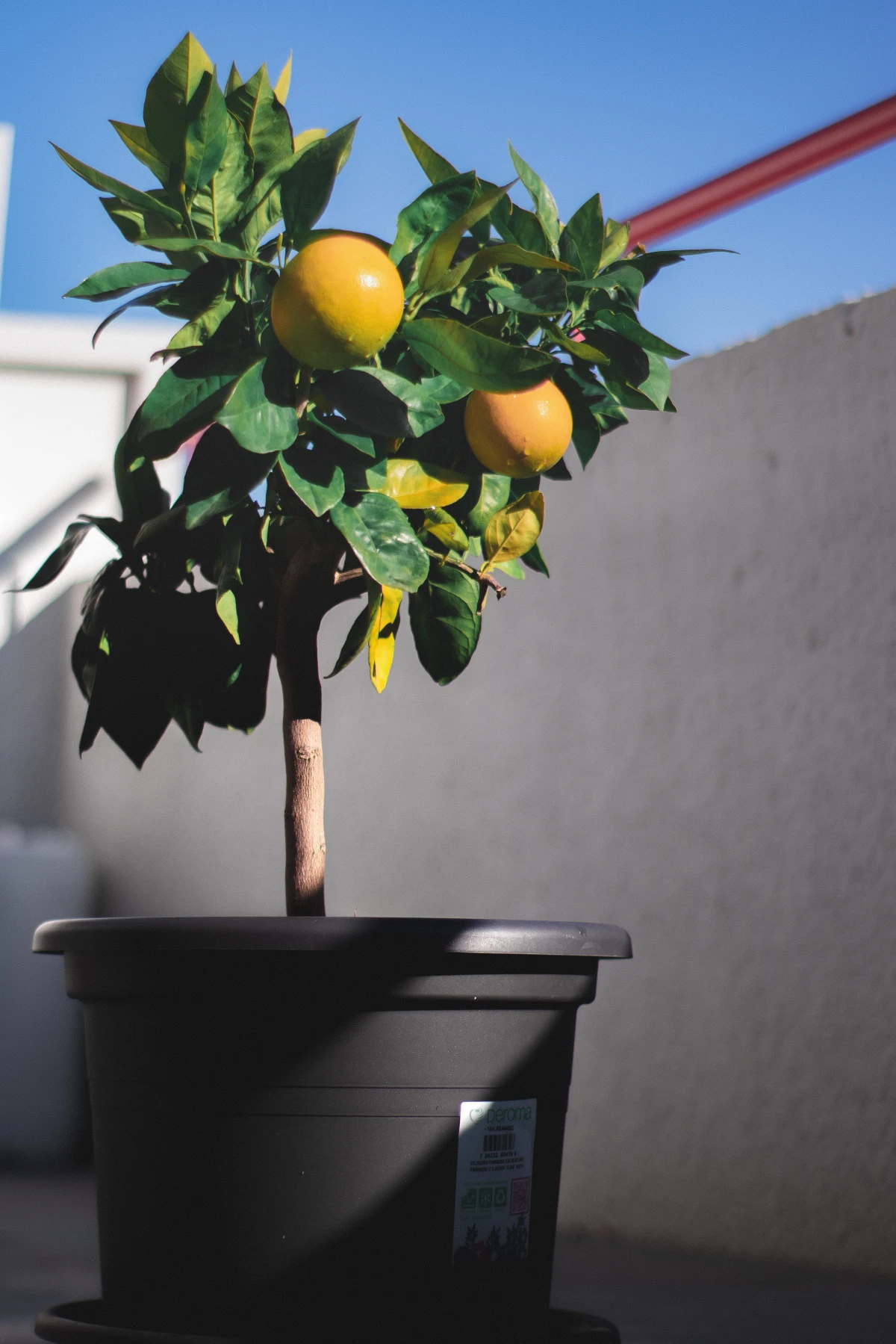
Your 5-Minute Task Before You Buy Anything
Seriously, do this right now. Go out to your patio or balcony—the exact spot where you imagine this beautiful tree living. Open the compass app on your phone. Does that spot actually get 6+ hours of direct sunlight? Or is it more like 4 hours of morning sun? Knowing your real sun exposure is the single most important decision-maker. Don’t guess!
Five Trees That Genuinely Thrive in Pots
I’ve tried a lot of different trees in containers over the years. Many are advertised as being great for pots but end up struggling after a season or two. These five are the ones I’ve personally grown and seen succeed for the long haul. They’re chosen because they can handle having their roots confined, they stay a manageable size, and they look fantastic.
1. Japanese Maple
These are the undisputed superstars of the container world, and for good reason. The delicate leaves, elegant shape, and knockout fall color make them an instant focal point. They’re not without their challenges, though.
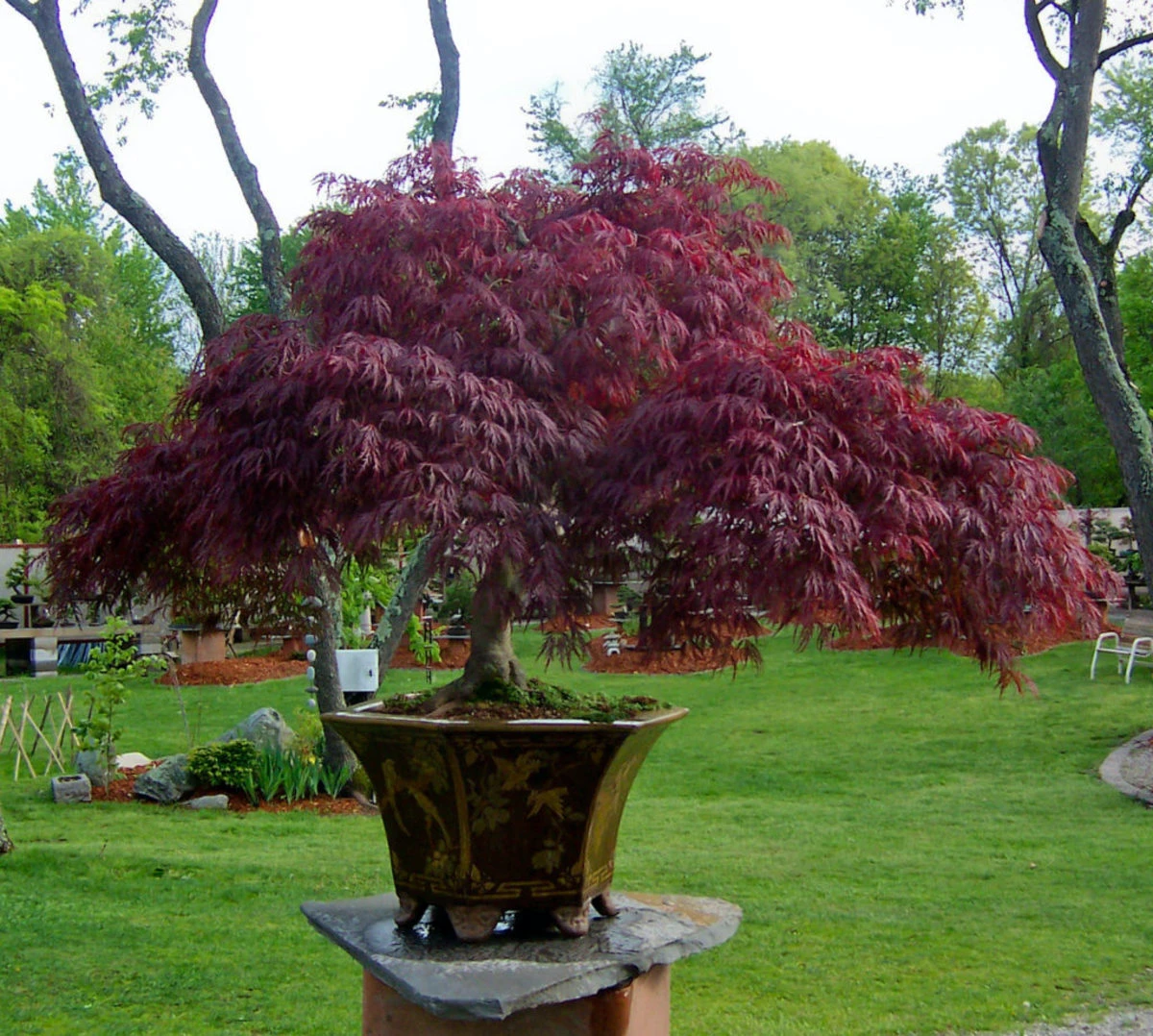
My Experience: The number one mistake I see is putting them in hot, direct afternoon sun. The leaves will scorch and get crispy brown edges. They’re happiest on a protected patio or entryway that gets only morning sun. For upright varieties in larger pots, I love the ones with a classic tree shape. For smaller spaces, a weeping laceleaf type spilling over the edge of a pot is just spectacular.
Pro Tips: They need a slightly acidic, super well-draining soil. My go-to mix is one part high-quality potting mix, one part composted pine bark fines (sometimes sold as ‘soil conditioner’ in the mulch aisle), and one part pumice for aeration. Prune them in late winter when they’re dormant to thin out crossing branches and let light and air in. Never take off more than a quarter of the canopy at once.
A Quick Budget: A starter 5-gallon tree might cost around $75-$125. A nice 18-inch fiberglass pot will be about $80. Add in quality soil and amendments for another $30. You’re looking at a startup cost of around $185 – $235.

2. Dwarf Citrus
There’s absolutely nothing like the smell of citrus blossoms on your own patio. Growing a dwarf Meyer Lemon, Calamondin Orange, or Bearss Lime in a pot is just so rewarding. You get glossy evergreen leaves, those amazing-smelling flowers, and fruit you can actually eat!
My Experience: In any climate with a real winter (Zone 8 or colder), these trees have to come inside. The transition is everything. In the fall, I move them to a shady, sheltered spot for about a week before bringing them in. In spring, I do the reverse to re-acclimate them. Heads up! Indoors, they are magnets for spider mites. I’ve learned to just be proactive and spray the undersides of the leaves with insecticidal soap every few weeks as a preventive measure.
Pro Tips: Citrus trees are hungry. They need a fertilizer specifically for citrus, which has extra iron, zinc, and manganese. I use a slow-release granular one in the spring and then give them a liquid feed every couple of weeks during the growing season. Let the top two inches of soil dry out, then water deeply.
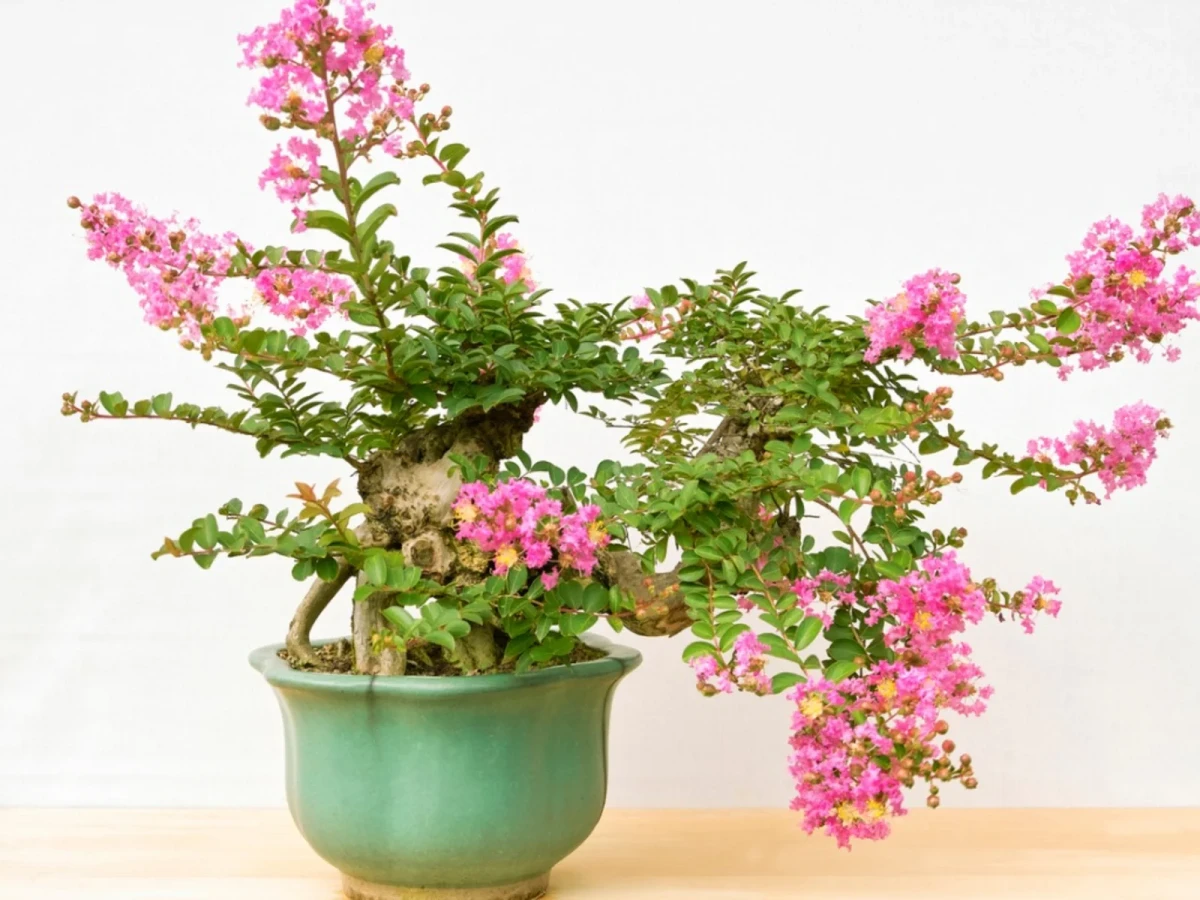
3. Olive Tree
If you want that sun-drenched, Mediterranean vibe, an olive tree is perfect. The silvery-green leaves and gnarled trunk add a sculptural, timeless feel. They are also incredibly tolerant of heat and drought, which makes them a fantastic choice for a hot, sunny balcony.
My Experience: The absolute biggest killer of potted olive trees is overwatering. I learned this the hard way early in my career—I treated one like a regular patio plant and nearly drowned it. Their roots will rot in a heartbeat if the soil stays wet. You need a mix that’s super gritty and drains fast. I often start with a commercial cactus/succulent mix and add about 30% compost for a little bit of nutrient-holding power.
Pro Tips: Don’t expect a big harvest of olives from a potted tree, especially if you don’t live in a Mediterranean climate. Grow it for its sheer beauty, and think of any fruit as a happy bonus. Oh, and check that drainage hole now and then. I’ve seen them get clogged with roots. If water isn’t pouring out the bottom when you water, you’ve got to fix it immediately, even if it means tipping the pot over and clearing the hole with a screwdriver.
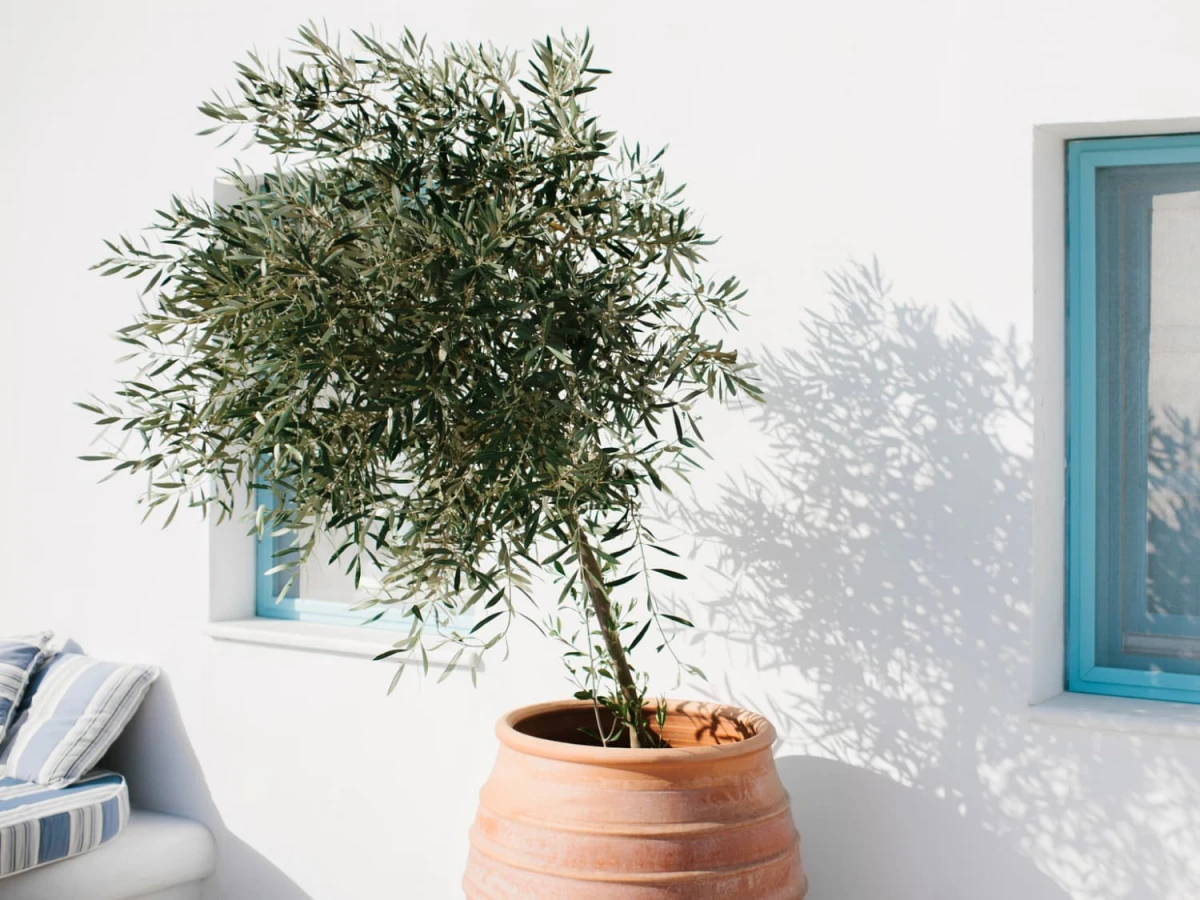
4. Bay Laurel
The Bay tree is a classic for a reason. It’s a handsome evergreen that’s incredibly tolerant of being pruned. This is the one to get if you’ve ever wanted to try your hand at topiary—shaping it into a ball, a cone, or that classic “lollipop” standard tree.
My Experience: I’ve trained dozens of these into formal shapes. It takes patience. You start with a young plant, stake its main stem perfectly straight, and slowly strip off the lower branches as it grows taller. Then you just shear the top into shape a few times a year. The smell of the leaves when you’re pruning is amazing, and yes, you can use them in your cooking!
Pro Tips: Bay trees are slow-growers, which is a huge plus in a pot. It means you only have to repot them every three or four years. They aren’t heavy feeders either; a single dose of a balanced, slow-release fertilizer in the spring is plenty. Look for something with a balanced N-P-K ratio like 14-14-14; Osmocote is a common brand that works well.
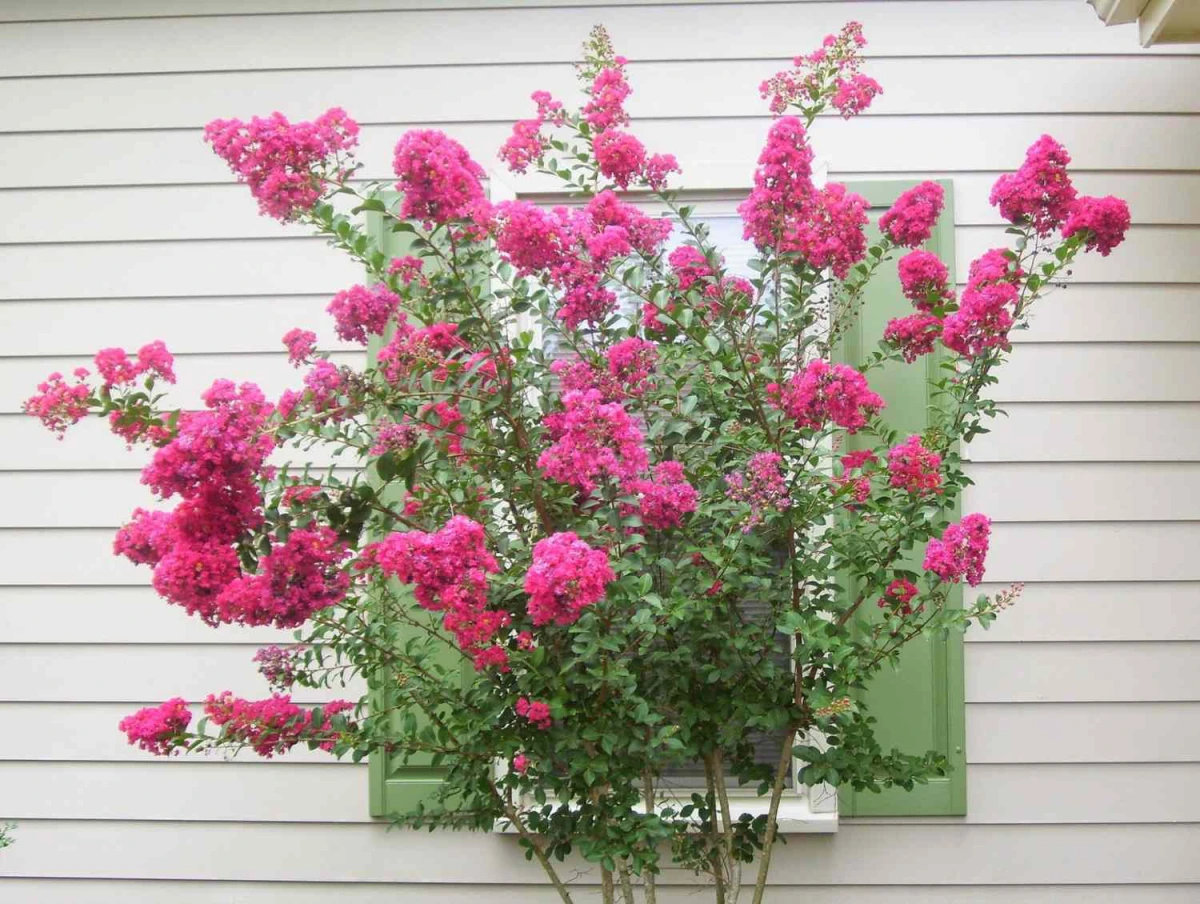
5. Dwarf Crape Myrtle
Want a huge burst of summer color? A dwarf crape myrtle is an incredible choice. Modern varieties stay under five feet tall and bloom their heads off for months. You get flowers, cool peeling bark, and even nice fall color.
My Experience: The key is to buy a true dwarf variety, not just a young version of a giant tree. Look for series names like ‘Pocomoke’ or Razzle Dazzle®. And full, direct sun is completely non-negotiable. I’ve seen people put them in part-shade, where they just get leggy and refuse to bloom. They need at least six hours of direct sun to put on a good show.
Pro Tips: Crape myrtles bloom on new growth, so you should prune them in late winter before they start growing. I just remove any dead wood and trim the whole plant back by about a third. This encourages strong new stems that can hold up the big flower clusters. Be aware, the flower and bark drop can be a bit messy on a deck, so plan on some regular sweeping.
The Nitty-Gritty: Potting, Repotting, and Long-Term Care
Okay, you’ve picked a tree. Now for the practices that will actually keep it alive and happy.
Pot Selection and Soil Mix
When you first buy your tree, choose a pot that’s only 2-4 inches wider than the nursery pot it’s in. A common mistake is putting a small plant in a giant pot. All that extra soil stays wet for too long, which is a recipe for root rot. It’s much better to pot up in size every few years. As for the pot itself? Terracotta is classic but dries out fast. Glazed ceramic is beautiful but can be incredibly heavy and expensive (a nice, large one can easily be $150-$300). Modern fiberglass and composite pots are a great middle-ground—lightweight, durable, and more affordable, often in the $60-$120 range for a good size.
And whatever you do, the pot MUST have a drainage hole. No exceptions.
My go-to soil recipe for most trees is simple:
- 50% High-Quality Potting Mix: This is your base. Don’t cheap out here. Spend the $20-25 for a good bag.
- 30% Pine Bark Fines: This stuff is gold. It adds structure and air pockets, preventing the soil from compacting. Look for it bagged as “soil conditioner” or “pine fines” near the mulch.
- 20% Pumice or Perlite: These little rocks create permanent air spaces for drainage. I prefer pumice because it’s heavier and doesn’t float to the top like perlite does.
Repotting: The Task Everyone Skips (But Shouldn’t)
Every two to three years, your tree will need to be repotted. This is probably the most important job in keeping a container tree healthy long-term. You’ll know it’s time when water seems to run straight through the pot without wetting the soil, or you can see roots circling the bottom.
It’s a scary process, but you can do it. Here’s how:
- Get a helper. Seriously, don’t do this alone. Lay the tree on its side on a tarp.
- Remove the tree. If it’s stuck, run an old serrated bread knife around the inside edge of the pot to loosen the root ball before you try to pull.
- Prune the roots. This is the crucial part. If the roots are a dense, tangled mat, you have to fix it. Use a sharp knife to shave off the outer 1-2 inches of the root ball on all sides and the bottom. It feels brutal, but it’s vital. It cuts those strangling, circling roots and encourages fresh, healthy growth.
- Repot. You can either put it back in the same pot with fresh soil all around or move up to the next size pot. Water it well and keep it in a shady spot for about a week to recover.
Winter Survival Guide
This is where many people lose their trees. In colder zones, you have to provide protection.
- For Japanese Maples & Crape Myrtles (Zones 7 and colder): The goal is to protect the roots from freezing solid. The easiest method is to move the pot into an unheated, attached garage or shed once the tree is dormant. It doesn’t need light, just shelter from wind and the coldest temps. If you can’t move it, you can try insulating. Group it with other pots against a warm wall and wrap the pot (not the tree itself) in bubble wrap or burlap.
- For Bay Laurel & Citrus (Zones 7 and colder): These need to come indoors to a bright location before the first hard frost. A south-facing window is ideal for citrus. The Bay can handle a cooler, less bright spot.
Finally, a word on safety and cost. A large, wet pot can weigh a ton. I’ve seen 30-inch pots that took four people to move. Be mindful of weight, especially on a deck or balcony. And be realistic about the budget. A healthy, beautiful container tree is an investment of time and money, but it’s one that can bring you joy for years and truly connect you to the seasons, right outside your door.
Inspirational Gallery
Terracotta Pots: These classic clay pots are porous, allowing air and water to move through the sides. This is great for root health and prevents waterlogging, but it also means the soil dries out very quickly in sun and wind, requiring more frequent watering.
Glazed Ceramic & Fiberglass Pots: These non-porous containers retain moisture much longer, reducing your watering duties. They come in a vast array of colors and styles, but can get very hot in direct sun, potentially cooking the roots. Choose lighter colors to reflect heat.
A 24-inch (60 cm) pot, once filled with damp soil mix and a small tree, can easily weigh over 150 lbs (70 kg).
Before you even think about soil, think about placement. Ensure your balcony or patio can handle the load. More importantly, place a heavy-duty plant caddy with locking wheels, like those from Bosmere or a DIY version, underneath the pot *before* you fill it. Your back will thank you when it’s time to move it for winter protection or to chase the sun.
Wondering how to feed a tree with such limited soil?
Container trees are heavy feeders and entirely dependent on you. In spring, mix a balanced, slow-release fertilizer like Osmocote Plus into the top layer of soil. This provides a steady nutrient supply for months. Supplement this during the peak growing season (late spring to mid-summer) with a weekly or bi-weekly dose of a liquid fertilizer, such as Neptune’s Harvest or a simple Miracle-Gro solution, diluted to half-strength to avoid burning the roots.
- Keeps your tree from becoming root-bound and choking itself.
- Allows the tree to live happily in the same container for many more years.
- Stimulates a flush of fresh, healthy growth in the canopy.
The secret is a technique called root pruning. Every 2-3 years, slide the tree out of its pot, trim off the outer 1-2 inches of the root ball with a sharp knife, and repot with fresh soil. It feels drastic, but it’s the key to long-term patio tree health.
The Orangerie at the Palace of Versailles has housed potted citrus trees, some centuries old, since 1663. They are moved indoors each winter into a dedicated, protected hall.
Don’t just think of your tree as a plant; think of it as an architectural and sensory element. The delicate, paper-like leaves of a Japanese Maple will create a serene, rustling sound in the slightest breeze, perfect for a zen-inspired space. For a Mediterranean feel, the silvery-green foliage of an olive tree is essential. And for pure fragrant indulgence on a summer evening, nothing beats a potted standard gardenia or a ‘Meyer’ lemon tree, whose blossoms will perfume your entire patio.
A common mistake: Believing a potted tree is a one-and-done purchase. Remember the article’s advice to treat it like a pet? That means planning for its future. An inexpensive, 3-foot fiddle-leaf fig may look perfect now, but it will quickly outgrow its space and pot, requiring a larger, heavier, and more expensive home in just a year or two. Sometimes, investing in a slow-growing dwarf variety from the start is the more sustainable choice, both for your wallet and your effort.
The bare soil at the top of a pot can look unfinished and dry out quickly. Consider adding a ‘top dressing’ for both aesthetic and practical benefits.
- For a modern look: Use smooth, dark river stones or slate chippings.
- For a natural vibe: A layer of preserved sphagnum or sheet moss holds in moisture beautifully.
- For a living mulch: Plant shallow-rooted, creeping groundcovers like ‘Elfin’ thyme or sedum, which can handle the dry conditions.
Do I need a special soil mix for my container tree?
Absolutely. Do not use soil from your garden. It’s too heavy, compacts easily, and carries pests and diseases. You need a mix that provides structure, aeration, and moisture retention. A great all-purpose recipe is to combine a high-quality potting mix (like FoxFarm Ocean Forest or Pro-Mix HP) with about 20-30% perlite or pumice for improved drainage, and a handful of compost for organic matter. This blend creates the perfect balance of air and water that container roots crave.
Many patio trees, especially citrus, olives, and figs, are not frost-hardy in colder climates. Plan your overwintering strategy before you buy. You’ll need a bright, cool spot indoors, like a garage with a window or an unheated sunroom. Drastically reduce watering—just enough to keep the soil from becoming bone-dry. Don’t be alarmed if it drops some leaves; it’s a natural response to the lower light levels. It will bounce back when it returns outdoors in spring.










